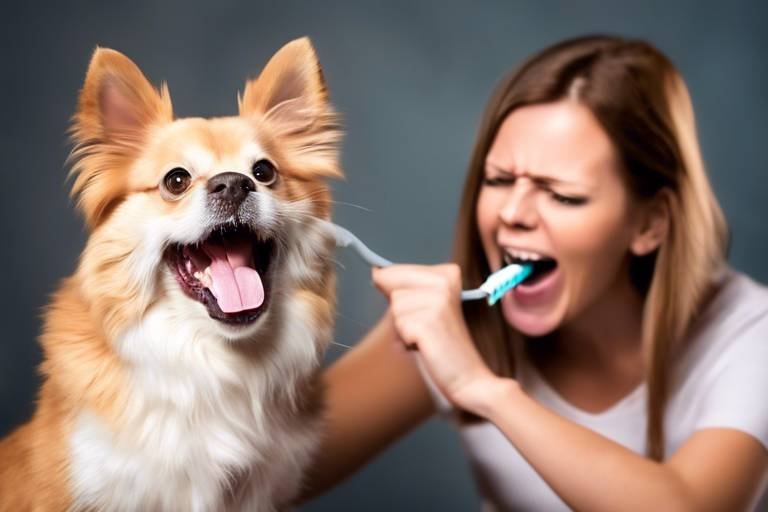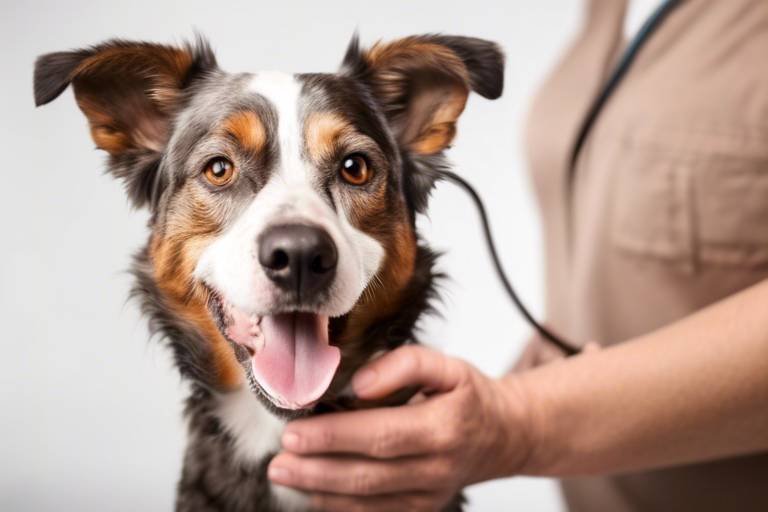How to Help Your Pet Cope with Change
Life is full of changes, and just like us, our furry friends can feel the impact of these transitions. Whether you're moving to a new home, welcoming a new family member, or altering your daily routine, it's crucial to ensure your pet feels secure and supported during these times. Pets, much like humans, experience a whirlwind of emotions when faced with change. They may feel anxious, confused, or even scared, which can lead to behavioral issues if not addressed properly. So, how can you help your beloved companion navigate these changes smoothly? Let's dive into some effective strategies that can make a world of difference for your pet.
Pets experience a range of emotions similar to humans. When change occurs, your pet may feel a mix of excitement and anxiety. Understanding these feelings is the first step in providing the support they need. For instance, a dog might bark more or hide away, while a cat could become more aloof. By recognizing these behaviors, you can better address their needs and create a nurturing environment that fosters emotional well-being. Remember, your pet looks to you for guidance, so being attuned to their feelings can help strengthen your bond.
One of the most effective ways to help your pet cope with change is by creating a designated safe space. This area should be quiet, comfortable, and filled with familiar items that remind your pet of home. Think of it as their little sanctuary where they can retreat when the world feels overwhelming. A cozy corner with their favorite blanket, a couple of toys, and perhaps a piece of your clothing can work wonders. These familiar scents and textures provide a sense of stability during uncertain times, allowing your pet to feel secure even when everything else feels chaotic.
Incorporating your pet's favorite toys, blankets, or beds into their safe space can provide immense comfort. Just like a child might cling to a stuffed animal during a scary moment, your pet can find solace in their treasured items. Familiar scents can help ease anxiety and create a sense of normalcy. If you’ve recently moved, try placing these items in a spot that gives them a view of their new surroundings. This way, they can observe the changes from a safe distance, gradually becoming accustomed to their new environment.
Consistency is key for pets. Just like we thrive on routine, our furry friends do too. Try to keep feeding, walking, and playtime schedules as regular as possible, even amidst changes. This predictability can help your pet feel more secure and reduce stress. For example, if you usually walk your dog at 7 AM, try to stick to that schedule. Even if your day is hectic, maintaining these routines can provide a comforting structure for your pet.
When introducing new changes, do so gradually. Allow your pet to acclimate to new environments or family members at their own pace. This can involve simple steps, such as letting your pet sniff a new family member's shoes before meeting them or allowing them to explore a new room slowly. Minimizing feelings of overwhelm promotes a smoother transition and helps your pet feel more in control of their surroundings.
Being aware of your pet’s stress signals is crucial. Changes in behavior, appetite, or energy levels can indicate that your pet is struggling. It's important to look for signs such as:
- Excessive barking or meowing
- Hiding or withdrawing
- Loss of appetite
- Destructive behavior
- Excessive grooming or licking
By recognizing these signs early, you can take appropriate action to help them cope, whether that means providing extra comfort, engaging in play, or seeking professional advice.
Using positive reinforcement techniques can encourage your pet to adapt to changes. Rewarding calm behavior with treats or praise can help create a positive association with new experiences. For instance, if your dog remains calm when meeting a new person, shower them with praise and a tasty treat. This not only reinforces their good behavior but also helps them associate new situations with positive outcomes.
Short training sessions can serve as a distraction and a way to bond with your pet. Teaching new commands or tricks can help redirect their focus and build confidence during stressful times. Plus, it’s a great way to engage their minds and strengthen your relationship. Consider incorporating fun games that challenge them mentally while also providing a safe outlet for their energy.
Providing opportunities for safe social interactions with other pets or people can help your pet adjust to changes. Positive social experiences can alleviate anxiety and promote a sense of normalcy. Whether it’s a playdate with a familiar dog or a visit to a pet-friendly park, these interactions can help your pet feel more comfortable in their surroundings.
If your pet shows persistent signs of distress, consulting a veterinarian or animal behaviorist may be necessary. Professional guidance can provide tailored strategies to support your pet's emotional health during transitions. Just like we seek help from professionals when we face challenges, our pets deserve the same level of care and attention.
1. How can I tell if my pet is stressed?
Look for changes in behavior, appetite, and energy levels. Signs include excessive barking, hiding, or destructive behavior.
2. What should I include in my pet's safe space?
Include familiar items like toys, blankets, and a comfortable bed. Familiar scents can help ease anxiety.
3. How long does it take for a pet to adjust to change?
Every pet is different. Some may adjust quickly, while others may take weeks or even months. Patience is key!
4. Can training help my pet cope with change?
Absolutely! Training can provide mental stimulation and help build confidence, making transitions smoother.

Understanding Your Pet's Emotions
Just like us, pets are emotional beings. They experience a wide range of feelings that can mirror our own, from joy and excitement to fear and anxiety. Understanding these emotions is crucial, especially during times of change. Have you ever noticed how your dog wags its tail when it's happy or how your cat hides when it’s scared? These behaviors are their way of communicating how they feel. By tuning into these signals, you can better support your furry friend through life's transitions.
When changes occur in your household—be it moving to a new home, bringing in a new family member, or even altering their daily routine—your pet may struggle to adapt. They might not understand why their world is shifting, and this can lead to feelings of uncertainty and stress. Just imagine how you would feel if you suddenly found yourself in a completely new environment without any explanation! To help your pet cope, it’s important to recognize the signs of emotional distress. Common indicators include:
- Changes in Behavior: Is your once-friendly pup now hiding under the bed? Or has your cat suddenly become more aggressive? These behavioral shifts can signal that your pet is feeling overwhelmed.
- Altered Appetite: If your pet is suddenly refusing food or overeating, it could be a sign of emotional turmoil.
- Excessive Vocalization: Increased barking or meowing can indicate anxiety or a plea for attention.
- Physical Symptoms: Stress can manifest physically, leading to symptoms like excessive grooming, trembling, or even gastrointestinal issues.
Recognizing these signs is the first step in helping your pet navigate their emotions. Just as we might seek comfort from friends or family during tough times, pets also need our support. By being attentive and responsive to their needs, you can create a more stable and nurturing environment. This not only helps ease their anxiety but also strengthens the bond you share.
Moreover, engaging in activities that promote emotional well-being is essential. Just like humans benefit from talking about their feelings, pets can also benefit from interactive play and training. These activities can provide a distraction from stress and help them feel more secure. When you see your pet relax and engage positively, you’ll know that your efforts are making a difference.
Understanding your pet's emotions is not just about recognizing when they’re upset; it’s also about celebrating their happiness and ensuring they feel loved and secure. By being proactive and attentive, you can help your four-legged family members thrive even in the face of change.

Creating a Safe Space
When life throws changes your way, whether it’s a move to a new home, the arrival of a new family member, or a shift in your daily routine, it’s essential to consider how these transitions affect your furry companions. Just like we seek comfort during uncertain times, our pets crave a safe haven where they can retreat and feel secure. Establishing a designated safe space for your pet can significantly reduce anxiety and help them navigate through these changes more smoothly.
Your pet's safe space should be a quiet and comfortable area in your home, away from the hustle and bustle. Think of it as their little sanctuary, a place where they can unwind and feel protected. This area should be equipped with familiar items that carry their scent—like their favorite blanket, toys, or bed. These familiar scents and textures can work wonders in easing anxiety, much like how a beloved childhood toy can bring back warm memories for us.
Consider the following elements when creating this space:
- Location: Choose a spot that is away from noisy appliances or high-traffic areas in your home. A cozy corner in a quiet room often works best.
- Comfort: Ensure the area has soft bedding or a comfortable mat where your pet can lounge. This will encourage them to use their safe space more often.
- Familiar Items: Incorporate their favorite toys, blankets, or even an item of your clothing. The presence of these familiar items can significantly reduce feelings of anxiety.
It's also crucial to maintain a routine around this safe space. Encourage your pet to spend time there, especially when they seem stressed. You can do this by offering treats or engaging in playtime in that area. Over time, your pet will associate this space with positive experiences, making it a go-to spot for comfort during times of change.
Furthermore, if you have multiple pets, ensure that each one has their own safe space. This prevents competition for the same area and allows each pet to feel secure in their own little world. Just as we all need our personal space, so do our pets.
In summary, creating a safe space for your pet is about providing them with a sanctuary that feels secure and familiar. By doing so, you’re not just helping them cope with change; you’re also strengthening the bond between you and your furry friend. It’s a small yet impactful step that can lead to a happier, more emotionally stable pet.
Q: How can I tell if my pet is feeling anxious?
A: Look for signs such as excessive barking, hiding, changes in appetite, or destructive behavior. If you notice these signs, it may be time to create a safe space for them.
Q: How long should I allow my pet to stay in their safe space?
A: There’s no set time limit. Allow your pet to spend as much time as they need in their safe space, especially during stressful situations. Gradually encourage them to come out when they feel ready.
Q: Can I use calming aids in their safe space?
A: Absolutely! Calming aids such as pheromone diffusers or anxiety wraps can be beneficial when used in conjunction with their safe space.
Utilizing Familiar Items
When it comes to helping your pet cope with change, one of the most effective strategies is to utilize familiar items. Just like humans find comfort in their favorite possessions during times of uncertainty, pets too can benefit immensely from their cherished belongings. Imagine how a child feels when they clutch their favorite stuffed animal during a scary moment; pets experience similar emotions and reactions. By surrounding your furry friend with familiar scents and textures, you can create a sense of stability that helps ease their anxiety.
Incorporating your pet's favorite toys, blankets, or beds into their designated safe space can work wonders. These items carry scents that are comforting and reassuring, allowing your pet to feel more at home even in unfamiliar situations. For instance, if your dog has a favorite chew toy, placing it in their safe area can provide a sense of familiarity. Similarly, a cat’s beloved blanket can create a cozy nook that feels secure amidst the chaos of change.
To highlight the importance of familiar items, consider the following:
- Toys: Their favorite toys can serve as a distraction and a source of comfort. They can engage in play, which not only alleviates stress but also reinforces positive feelings.
- Blankets: A blanket that smells like home can be a calming presence. It’s like a hug from the past, reminding them of happier, more stable times.
- Beds: Keeping their bed in a familiar spot can help your pet retain a sense of ownership and comfort, making it easier for them to relax.
Additionally, it’s crucial to ensure that these familiar items are accessible. If your pet is feeling overwhelmed, they should be able to retreat to their safe space and find their favorite things without any obstacles. Think of it as creating a sanctuary for them—a little haven where they can escape and recharge.
Moreover, you might want to consider introducing new items gradually. If you’re thinking of getting your pet a new bed or toy, don’t just throw it into the mix all at once. Instead, allow them to explore these new additions at their own pace, ensuring that their cherished items remain prominent. This way, they can create positive associations with the new items while still having their familiar comforts nearby.
In summary, utilizing familiar items can significantly ease your pet's transition during times of change. By creating an environment that is rich with comforting scents and textures, you’re not just helping them cope; you’re actively promoting their emotional well-being. Remember, every little bit of familiarity counts, and it can make all the difference as your furry friend navigates through the ups and downs of life.
- What types of familiar items should I use for my pet? Any items that your pet has a strong attachment to, such as toys, blankets, or beds, can be beneficial.
- How can I help my pet adjust to new environments? Gradually introduce them to new spaces while ensuring they have access to their familiar items.
- What if my pet doesn't seem to respond to familiar items? If your pet shows persistent signs of distress, consider consulting a veterinarian or animal behaviorist for tailored advice.
Maintaining Routine
When it comes to helping your pet cope with change, one of the most effective strategies is maintaining a consistent routine. Just like humans, pets thrive on predictability. Imagine how you feel when your daily schedule is thrown off—it's disorienting, right? Well, your furry friend experiences similar feelings. By keeping their feeding, walking, and playtime schedules as regular as possible, you provide a sense of stability and comfort during times of transition.
Consider this: if your pet knows that dinner is served at 6 PM every day, suddenly changing that time can create confusion and anxiety. Instead, try to stick to the same times for meals and walks, even if your life is a bit chaotic. This consistency can be a beacon of reassurance for them, helping to mitigate stress. For instance, if you’re moving to a new home, try to keep the same feeding schedule, and walk them through familiar routes if possible. This way, they can still associate certain times of the day with positive experiences.
Moreover, creating a daily schedule that includes all their activities can be beneficial. Here’s a simple example of what that might look like:
| Time | Activity |
|---|---|
| 7:00 AM | Breakfast |
| 8:00 AM | Morning Walk |
| 12:00 PM | Playtime |
| 5:00 PM | Dinner |
| 7:00 PM | Evening Walk |
In addition to regular feeding and walking times, incorporating playtime into their routine can also help maintain their emotional well-being. Engaging in activities that your pet enjoys can distract them from the changes happening around them. Whether it's a game of fetch, tug-of-war, or simply cuddling on the couch, these moments of connection can reinforce their sense of security.
Lastly, be patient. Changes in routine can take time for pets to adjust to. If you notice any signs of distress during this period, such as excessive barking, hiding, or changes in appetite, it may be a sign that they need more reassurance. Just remember, keeping a consistent routine is like providing a comforting blanket; it wraps them in familiarity and love, helping them navigate the stormy seas of change with a little more ease.
- How long does it take for a pet to adjust to a new routine? Every pet is different, but typically it can take anywhere from a few days to a few weeks. Be patient and consistent.
- What if my pet refuses to eat during a change? This can be common. Ensure they have access to their favorite foods and try to maintain their feeding schedule. If it persists, consult a veterinarian.
- Can I introduce new activities during a transition? Yes! New activities can be beneficial, but introduce them gradually to avoid overwhelming your pet.
Gradual Introductions
When it comes to helping your pet cope with change, are essential. Think of it like introducing a new friend to your circle; you wouldn't throw them into a party of a hundred people right away, would you? Similarly, your pet needs time to adjust to new surroundings or family members. This process can be made smoother by allowing your furry friend to acclimate at their own pace. Start by giving them a chance to explore new spaces without overwhelming them. For example, if you’ve just moved into a new home, let your pet wander around the less crowded areas first. This allows them to familiarize themselves with their new environment without feeling anxious.
When introducing new family members, whether they’re human or another pet, consider the following steps:
- Initial Encounters: Keep the first meetings short and sweet. Let your pet sniff and observe the new person or animal from a distance before any direct interactions.
- Positive Reinforcement: Reward your pet with treats and praise during these introductions. This will help create a positive association with the new presence in their life.
- Supervised Interactions: Gradually increase the time spent together, always supervising to ensure everyone feels safe and comfortable.
It's also important to pay attention to your pet's body language during these introductions. Signs of stress—like a tucked tail, flattened ears, or excessive panting—can indicate that your pet needs a break. If you notice these signals, don't hesitate to give them some space. Just like us, pets can feel overwhelmed, and respecting their boundaries will help build trust and confidence.
Incorporating gradual introductions into your pet's transition process not only helps reduce their anxiety but also fosters a sense of security and comfort. Remember, patience is key! Every pet is unique, and what works for one may not work for another. By taking the time to introduce changes slowly, you'll be setting your pet up for a much smoother adjustment period.
Q: How long should I take for gradual introductions?
A: The timeline can vary depending on the pet's personality and the nature of the change. Generally, a few days to a couple of weeks can be appropriate. Monitor your pet's comfort level and adjust accordingly.
Q: What if my pet shows aggression during introductions?
A: If your pet displays aggression, it's crucial to separate them immediately and give them space. Consider consulting a professional trainer or behaviorist for guidance on managing aggressive behavior.
Q: Can I use toys to help with introductions?
A: Absolutely! Toys can serve as a great distraction and help create positive interactions. Just be sure to supervise playtime to ensure safety.
Recognizing Signs of Stress
Just like us, our pets can experience stress, and it's essential to be vigilant in recognizing the signs that indicate they might be feeling overwhelmed. Understanding these signals is crucial for providing the right support and care. Pets can’t verbally express their feelings, so we need to tune into their behavior and body language. For example, a sudden change in their usual demeanor might be a red flag. Are they acting more withdrawn than usual? Or perhaps they’re exhibiting unusual aggression? These changes can be subtle but are often telling. Here are some common signs of stress to watch for:
- Excessive Barking or Meowing: If your dog is barking more than usual or your cat is meowing incessantly, it might be a sign of anxiety.
- Changes in Appetite: A stressed pet may lose interest in food or, conversely, may overeat as a coping mechanism.
- Destructive Behavior: Chewing, scratching, or other forms of destruction can indicate that your pet is trying to cope with stress.
- Hiding or Withdrawal: If your pet suddenly seeks solitude or hides away, it may be feeling overwhelmed.
- Changes in Grooming Habits: Over-grooming or neglecting grooming can signal stress in pets.
Being aware of these signs allows you to take proactive steps to alleviate your pet's stress. For instance, if your pet is hiding more often, consider creating a cozy, quiet space for them to retreat to when they feel anxious. If they are exhibiting destructive behavior, it might be time to engage them in more play or provide them with interactive toys to channel their energy positively.
Moreover, keeping a close eye on their body language can also provide insights into their emotional state. Signs such as a tucked tail, flattened ears, or dilated pupils can indicate fear or discomfort. On the other hand, a relaxed posture, wagging tail, or soft eyes may suggest that your pet is feeling secure and happy. Regularly observing your pet’s behavior can help you identify any shifts that might signal stress, enabling you to respond appropriately and nurture their emotional well-being.
Q: How can I tell if my pet is stressed?
A: Look for signs such as changes in appetite, excessive vocalization, destructive behavior, or withdrawal. Keep an eye on their body language for additional clues.
Q: What should I do if I notice signs of stress in my pet?
A: Create a safe and comfortable environment, maintain routine, and engage in positive reinforcement. If stress persists, consult a veterinarian or animal behaviorist.
Q: Can stress affect my pet's health?
A: Yes, prolonged stress can lead to health issues such as digestive problems, weakened immune response, and behavioral issues. It's important to address stress promptly.
Q: How long does it take for a pet to adjust to changes?
A: Every pet is different. Some may adapt quickly, while others may take weeks or even months. Patience and consistent support are key.

Engaging in Positive Reinforcement
Engaging in positive reinforcement is one of the most effective ways to help your pet adapt to changes in their environment. Imagine your pet as a sponge, soaking up experiences and emotions. When you reward them for calm behavior, you’re essentially teaching them that change can be a good thing. This technique not only helps them learn but also strengthens the bond between you and your furry friend.
When you think about it, we humans respond well to encouragement, right? Just like how a compliment can brighten your day, a treat or a kind word can make your pet feel secure and appreciated. By using positive reinforcement, you can create a safe learning environment where your pet feels confident to explore new situations without fear. This method is especially useful during times of transition, such as moving to a new home or welcoming a new family member.
One effective way to implement positive reinforcement is through training sessions. These don’t have to be long or tedious; in fact, short and fun training sessions can be incredibly beneficial. For example, you might teach your dog a new trick or work on basic commands like “sit” or “stay.” Each time they successfully follow your command, reward them with a treat or enthusiastic praise. This not only diverts their attention from the stress of change but also builds their confidence.
Additionally, consider incorporating socialization opportunities into your routine. Allowing your pet to interact with other animals or friendly people can help them adjust to changes more smoothly. Think of it as a mini-party for your pet! When they encounter new experiences in a positive context, it can significantly reduce their anxiety. Just remember to supervise these interactions to ensure they remain safe and enjoyable.
To further illustrate the benefits of positive reinforcement, here’s a simple table summarizing some techniques you can use:
| Technique | Description | Benefits |
|---|---|---|
| Training Sessions | Short, fun sessions where pets learn new commands or tricks. | Builds confidence, diverts attention from stress. |
| Socialization | Allowing pets to interact with other animals and people. | Reduces anxiety, promotes positive experiences. |
| Treat Rewards | Giving treats for calm behavior or following commands. | Encourages desired behavior, strengthens the bond. |
In conclusion, engaging in positive reinforcement not only helps your pet cope with change but also enhances your relationship with them. It’s all about creating a supportive atmosphere where your pet feels loved and secure. Remember, patience is key! Every pet is unique and may respond differently to various techniques. So, keep experimenting until you find what works best for your furry companion.
Q: How long should training sessions be?
A: Training sessions should be short and engaging, ideally lasting between 5 to 10 minutes to maintain your pet's attention.
Q: Can I use positive reinforcement for all pets?
A: Yes! Positive reinforcement can be effective for most pets, including dogs, cats, and even small animals like rabbits and guinea pigs.
Q: What if my pet doesn't respond to treats?
A: Some pets may be more motivated by praise or playtime rather than treats. Experiment with different rewards to see what your pet prefers.
Q: How do I know if my pet is stressed?
A: Signs of stress in pets can include changes in behavior, appetite, or energy levels. Pay attention to these signals to better support your pet.
Training Sessions
Engaging in with your pet can be a fantastic way to help them cope with changes in their environment. Think of it as a bonding experience—not just for teaching commands, but also for building trust and confidence. When your pet is faced with a new situation, their instinct might be to retreat or react negatively. However, by introducing them to fun and rewarding training sessions, you can redirect that energy into something positive.
Start with short, focused training sessions that last about 5 to 10 minutes. This keeps your pet engaged without overwhelming them. Use their favorite treats as a reward for following commands or learning new tricks. This not only reinforces good behavior but also creates a positive association with the training itself. For instance, if your dog is anxious about a new family member, teaching them to sit or shake hands can distract them from their worries and give them a sense of accomplishment.
Incorporate a variety of commands and tricks to keep things interesting. Here are a few ideas to get you started:
- Basic commands like "sit," "stay," and "come."
- Fun tricks such as "roll over" or "play dead."
- Agility exercises that involve jumping over small obstacles or weaving through cones.
Make sure to keep the atmosphere light and fun. Use an enthusiastic tone of voice, and don’t forget to celebrate the small victories! This can be as simple as giving your pet a big cheer or a gentle pat on the back when they successfully complete a command. The key is to ensure that your pet feels rewarded and appreciated, which will help boost their confidence and make them more willing to engage in future training sessions.
Remember, the goal of these training sessions is not just to teach your pet new skills, but also to provide a comforting routine that can help them navigate through changes. Just like humans, pets thrive on structure and predictability. So, by incorporating training into their daily routine, you’re giving them a sense of normalcy amidst the chaos of change.
Lastly, don’t hesitate to get creative with your training. You can even involve family members in the sessions to help your pet get used to new faces and voices. This not only helps in socializing your pet but also strengthens the bond between your pet and your family, making transitions smoother for everyone involved.
Q: How long should training sessions last?
A: Aim for 5 to 10 minutes per session to keep your pet engaged without overwhelming them.
Q: What if my pet doesn’t seem interested in training?
A: Try using higher-value treats or toys that they love, and ensure the environment is free of distractions.
Q: Can training help with my pet's anxiety?
A: Yes! Training sessions can provide a positive distraction and build confidence, helping to alleviate anxiety during transitions.
Socialization Opportunities
When it comes to helping your pet cope with change, socialization plays a vital role. Just like humans, pets thrive on interaction and companionship. Engaging your furry friend in positive social experiences can be a game-changer, turning stressful situations into opportunities for growth and comfort. Think of it as a bridge, connecting your pet to a world that feels a little less daunting and a lot more familiar.
One of the best ways to facilitate socialization is to introduce your pet to other animals and people in a controlled environment. This could be at a local park, during a playdate with a friend’s pet, or even at a pet-friendly event. The key is to ensure these interactions are positive and stress-free. You wouldn’t throw someone into the deep end of a pool without teaching them how to swim first, right? The same principle applies here. Start slow, and allow your pet to explore new relationships at their own pace.
Consider enrolling your pet in a training class or a socialization group. These classes not only provide structured learning but also offer a safe space for your pet to meet others. They can learn valuable skills while interacting with different dogs and people, which can help reduce anxiety and build confidence. Just imagine your shy pup transforming into a social butterfly, all because of a little encouragement and the right environment!
Additionally, regular outings can help your pet adjust to changes in their surroundings. Whether it’s a trip to the vet, a walk around the neighborhood, or a visit to a dog-friendly café, these experiences can help normalize new situations. If your pet is exposed to various environments and social settings, they’ll learn to navigate changes with ease. It’s like giving them a toolkit filled with resources to handle whatever life throws their way.
However, it’s essential to monitor your pet’s reactions during these socialization opportunities. Each pet has its own personality and comfort level. Some might be eager to make new friends, while others may prefer to observe from a distance. Always respect their boundaries and provide them with the option to retreat if they feel overwhelmed. Creating a balance between exposure and comfort is crucial for a successful socialization experience.
In summary, providing your pet with socialization opportunities not only helps them adapt to changes but also enriches their life. By fostering connections with other pets and people, you’re not just helping them cope; you’re enhancing their overall well-being. So, take the plunge and create those moments of interaction. Your pet will thank you for it!
- How can I tell if my pet is stressed during socialization? Look for signs such as excessive barking, hiding, or changes in body language. If your pet seems uncomfortable, it’s best to give them space.
- What should I do if my pet is aggressive towards other animals? Consult a professional trainer or behaviorist who can provide tailored strategies to manage aggression and improve social skills.
- How often should I socialize my pet? Regular socialization is beneficial, but it’s important to tailor the frequency to your pet’s comfort level. Start with short, positive interactions and gradually increase as they become more comfortable.

Seeking Professional Help
While many pet owners can manage their furry friends' emotional needs during times of change, there are instances when seeking professional help becomes essential. If you notice that your pet is exhibiting persistent signs of distress—such as excessive barking, hiding, or changes in eating habits—it's crucial to take action. Just like humans, pets can experience anxiety and depression, and sometimes they need a little extra support to navigate through tough transitions.
Consulting a veterinarian is often the first step. They can rule out any medical issues that could be contributing to your pet's behavior. For instance, a sudden change in appetite or lethargy might indicate a health problem rather than emotional stress. Once health concerns are addressed, a veterinarian can provide advice on behavioral issues or suggest a referral to an animal behaviorist.
Animal behaviorists specialize in understanding the psychological aspects of pet behavior. They can offer tailored strategies to help your pet cope with change. This might include customized training techniques, environmental adjustments, or even recommendations for calming products. Imagine having a roadmap that guides you through the emotional landscape of your pet's world—this is what a behaviorist can provide.
When considering professional help, it’s also important to look for certifications and experience. Here’s a quick rundown of what to look for:
| Criteria | What to Look For |
|---|---|
| Certifications | Look for credentials from recognized organizations such as the Association of Professional Dog Trainers (APDT) or the International Association of Animal Behavior Consultants (IAABC). |
| Experience | Choose professionals with a proven track record in dealing with the specific issues your pet is facing, such as anxiety or aggression. |
| Approach | Ensure their methods align with your values—positive reinforcement is generally the most effective and humane approach. |
In summary, seeking professional help can be a game-changer for your pet during challenging times. Whether it's through veterinary care or specialized behavioral training, the right support can make a world of difference in helping your furry companion feel secure and loved. Remember, your pet relies on you, and taking the initiative to seek help shows just how much you care.
- How do I know if my pet needs professional help? If your pet shows ongoing signs of stress or behavioral changes that last more than a few days, it's time to consult a professional.
- What should I expect during a consultation? Expect a thorough assessment of your pet's behavior, environment, and health history. The professional will work with you to create a tailored plan.
- Are there any home remedies that can help? While some calming products can be beneficial, they should not replace professional advice, especially for severe anxiety.
Frequently Asked Questions
- How can I tell if my pet is stressed during a transition?
Pets can show stress in various ways, including changes in behavior, appetite, or energy levels. If your furry friend is hiding, excessive barking, or refusing to eat, these could be signs that they are feeling overwhelmed. Paying attention to these signals can help you address their needs effectively.
- What should I include in my pet's safe space?
Your pet's safe space should be a cozy, quiet area filled with familiar items. This can include their favorite toys, blankets, or beds. Familiar scents and textures can create a comforting environment, helping them feel secure during changes.
- How important is routine for my pet during changes?
Maintaining a consistent routine is crucial for pets during transitions. Keeping feeding, walking, and playtime schedules regular can provide a sense of stability, helping your pet feel more secure and less anxious amidst changes.
- What are some effective ways to introduce new family members to my pet?
Gradual introductions are key. Allow your pet to meet new family members at their own pace, ensuring that interactions are positive and stress-free. This approach minimizes feelings of overwhelm and fosters a smoother adjustment for your pet.
- When should I seek professional help for my pet?
If your pet shows persistent signs of distress, such as ongoing anxiety or behavioral changes, it may be time to consult a veterinarian or animal behaviorist. Professional guidance can provide tailored strategies to support your pet's emotional health during transitions.
- How can positive reinforcement help my pet cope with change?
Positive reinforcement techniques, like rewarding calm behavior with treats or praise, can help your pet associate new experiences with positive outcomes. This encourages them to adapt more easily to changes in their environment.
- Are short training sessions beneficial during stressful times?
Absolutely! Short training sessions can serve as a great distraction and a bonding opportunity. Teaching your pet new commands or tricks can redirect their focus, build confidence, and help them feel more secure during stressful periods.
- How can socialization opportunities help my pet?
Providing safe social interactions with other pets or people can alleviate anxiety and promote a sense of normalcy. Positive social experiences can help your pet adjust to changes and feel more comfortable in new situations.



















